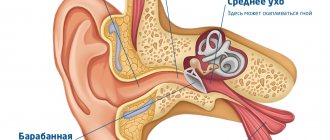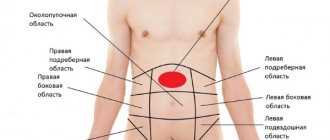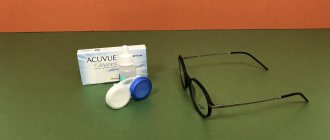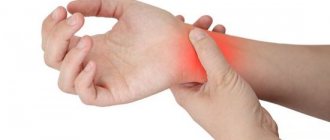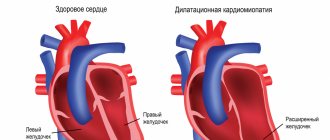Eye pain is a symptom of a serious illness!
Therefore, do not self-medicate, but consult a doctor. You can make an appointment at a time convenient for you.
Leave your phone number. The clinic administrator will call you back.
Make an appointment
Appointment with an ophthalmologist
from 750 rub.
We all experience eye pain at some point in time. Sometimes it goes away on its own, and sometimes it persists for a long time. Doctors at the Laser Eye Microsurgery Clinic on Maerchak warn that eye pain can be caused by serious diseases. Therefore, if you experience eye pain, consult a doctor.
Causes of eye pain
There are several serious diseases whose symptoms include pain inside the eye. Many of them require urgent treatment, so establishing the true cause of pain inside the eyes must occur quickly.
The main etiological factors that cause acute pain inside the eyeball are the following:
- Angle-closure glaucoma. The pathology is caused by a sharp increase in intraocular pressure due to improper circulation of ocular fluid. With this anomaly, pain can occur suddenly and increase at a high rate. In addition to pain in the eyeball, this condition is accompanied by visual disturbances - scotoma, rapid increase in myopia, changes in color vision, a feeling of strong pressure in the eyes, headache and nausea.
- An attack of ocular hypertension provoked by a violation of the circulation of the intraocular fluid. Increased pressure inside the eye worsens in the morning and can spontaneously subside in an upright position. In addition to discomfort, an increase in the vascular pattern on the conjunctiva is observed directly in the eye, and sometimes hemorrhage in the membrane of the eye.
- Increased intracranial pressure due to traumatic brain injury, hemorrhagic stroke, cerebral hematomas, meningitis and encephalitis, tumors and other pathologies. With this anomaly, patients complain of periodically increasing pain inside the eye. Symptoms increase when lying down, when coughing, sneezing, or other types of stress. Additionally, there is a slight decrease in visual acuity, which can progress with increased pain.
- Neuralgia of the trigeminal or supraorbital nerve. In such conditions, pain inside the eye is localized on one side and limited to the cheekbone, part of the nose with damage to the trigeminal nerve or the orbit of the eye, brow ridge and part of the forehead with supraorbital neuralgia. Additional symptoms are lacrimation on the affected side, increased pain when trigger points are irritated.
- Optic neuritis due to sinusitis, damage to the myelin sheath (sclerosis), inflammation of the orbit. The pathology is accompanied by pain inside the eyeball that intensifies when turning, a change in the perception of colors, a decrease in visual acuity and the appearance of spots in the visual field.
- Inflammation of the eyeball. The patient complains of acute constant pain inside the eye and increased body temperature. Visually visible swelling of the conjunctiva, redness of the eyelids, decreased vision on the affected side.
Pain syndrome inside the eye is also provoked by cluster headaches and migraines. Such anomalies are more common in women of fertile (childbearing) age. The pain in most cases is paroxysmal, intense, occurs suddenly, and lasts from several hours to several days. In addition to pain inside the eye, the condition is accompanied by lacrimation on the affected side, inflammation and redness of the cornea, general depression, attacks of irritability, intolerance to light, sounds, etc.
In isolated cases, behind the symptoms of inflammation of the eyeball, neuritis and neuralgia, glaucoma and other ophthalmological pathologies, another anomaly is hidden that is not related to the visual organs. Most often they are sinusitis, frontal sinusitis, gumboil, deep damage to the roots of teeth by caries.
Causes of increased visual fatigue
Why does vision deteriorate? The main reasons for this phenomenon are identified:
High strain on the eyes.
This is often encountered by schoolchildren and students who are forced to read and write a lot, as well as office workers whose work involves continuously sitting at a computer or reading documents.
Also, if you are fond of computer games, like to watch TV series from mobile gadgets - smartphones or tablets - or spend all your free time with a book, your eyes are also subject to high strain.
To minimize problems with this lifestyle, it is necessary to take breaks as often as possible and provide your eyes with regular rest.
Computer vision syndrome.
This is a whole complex of symptoms that is caused by overstrain of the visual system due to prolonged use of the computer. The reason for the development of the symptom is not so much the need to look at the monitor for a long time, but rather a functional change in your posture, eyes, and neck. For example, constant glancing from the keyboard to the monitor and back leads to accommodative asthenopia, which is manifested by discomfort, eye fatigue, pain, pain in the superciliary region, and blurred vision of the object of fixation.
Subsequently, this can provoke disorders such as myopia (myopia), accommodation spasm (inability to focus on small objects and details) and dry eye syndrome.
A properly organized workplace and touch typing skills will help minimize the harm from constant work at the computer.
Dry eye syndrome.
It often appears due to computer vision syndrome and develops due to insufficient hydration of vision: when concentrating on the computer, a person blinks less often, as a result of which the tear film dries out. Plus, the air near the computer heats up and also becomes dry.
Organize your workspace and use special glasses for working at the computer
In the summer season, when air conditioning is used in the premises, the pathological effect of dry air on the eyes only intensifies. And if you use contact lenses, the syndrome develops even faster.
To reduce the negative impact of external factors and provide more comfortable conditions for your eyes, place a humidifier near your workplace. Also buy moisturizing drops (they should be selected with the help of an ophthalmologist) and use them several times a day. If possible, try to blink more often.
Diagnosis of pain inside the eye
To diagnose eye pain, a comprehensive ophthalmological examination is performed. Before it, instillation of analgesics is recommended, since pain leads to blepharospasm, which complicates examination. After this, visual and instrumental studies are carried out:
- visometry - measuring visual acuity using tables;
- non-contact tonometry - measurement to detect increased pressure inside the eyes;
- biomicroscopy - examination of the front side of the eyeball using a slit lamp, revealing corneal defects, inflammation and other pathologies;
- ophthalmoscopy - measurement of the transparency of the optical media of the eye and visual examination of the retina for pathologies;
- Ultrasound of the eyeball is a wave diagnostic method that helps diagnose developmental anomalies and defects of all eye structures;
- X-ray of the eye is a radiation diagnostic method that detects foreign bodies and defects of bone structures in the orbital area.
If a secondary nature of pain is suspected, general studies are carried out: blood and urine tests, tests for specific and nonspecific microflora, functional diagnostics.
If only the left or right eye hurts inside
Know! If it hurts only in the left or right eye, this is a good sign, since in this case the cause of these sensations can be accurately determined. It could be:
- eye injury , which is also accompanied by swelling of the organ of vision itself and the periocular area and redness of the conjunctiva. In such cases, the integrity of the ocular vessels is often compromised, which leads to hemorrhages and redness of the conjunctiva;
- chemical, thermal or light burns, which sometimes cause pain in both eyes; In this case, pain most often appears several hours after receiving a burn;
- foreign object entering the eye.
In the latter case, no specific treatment is required except for the use of antibacterial ophthalmic drops after removing the foreign body (this process can be done independently or you can seek help from specialists).
Treatment
The choice of treatment methods depends on the causes of unpleasant symptoms. Tactics can vary significantly in patients experiencing similar symptoms, but having a different list of pathologies.
See what treatment for eye pain is used for various diseases in the table below.
| Disease | Conservative therapy | Surgical/minimally invasive intervention |
| Glaucoma | Instillation of miotic drugs within the first 2 hours after admission to the hospital. Analgesics intramuscularly (diphenhydramine, promedol, aminazine). Intravenous administration of mannitol and glycerol to equalize IOP. | Iridectomy is a laser operation through which the doctor creates an opening between the anterior and posterior chambers of the eye to restore the circulation of intraocular fluid. |
| Ophthalmohypertension | Antihypertensive drugs: ● systemic diuretics; ● inhibitors of VGZ synthesis; ● beta-blockers. Additionally, combined analgesics are used. | Not required. |
| Increased intracranial pressure | Pressure control methods: ● taking diuretics; ● compliance with the drinking regime; ● diet; ● physiotherapy; ● manual therapy. | Shunting is the implantation of shunts (tubes) to drain excess fluid (CSF) from the skull. |
| Optic or trigeminal neuralgia | To relieve pain, a complex of anti-inflammatory, anticonvulsant, sedatives and antidepressants is used. Additionally, physiotherapy, acupuncture, and electrical stimulation are used. | Microsurgical intervention aimed at eliminating compression of nerves. |
| Optic neuritis | Prescribed drugs to eliminate the causes of neuritis: ● antibiotics for bacterial infections; ● antiviral agents for viral inflammation (herpes). Additionally, systemic anti-inflammatory drugs are prescribed, as well as glucocorticosteroids (administered retrobulbarly, that is, inside the eye). | Not applicable. |
| Inflammation of the eyeball | A course of antibiotics and anti-inflammatory drugs of systemic and local action is prescribed. To increase the effectiveness of treatment of inflammation of the eyeball, hormonal drugs are used - prednisolone, hydrocortisone. | Used only in the presence of abscesses. The intervention is carried out in an outpatient setting. The doctor opens the purulent cavity, washes it, and applies a bandage. |
| Cluster headaches and migraines | Therapy is aimed at eliminating headaches and restoring normal vascular tone. Ergotamines, triptans, prescription analgesics, anesthetics, and antiepileptic drugs are used. To improve the condition, physiotherapy and exercise therapy are used. | Not applicable. |
conclusions
Simple gymnastics, which should be performed regularly throughout the day, will help quickly relieve eye fatigue. But this is not enough! To make your eyes less strained and tired, it is important to provide the right conditions:
- Organize your workplace according to all the rules;
- Install a humidifier near your workplace;
- Use moisturizing drops throughout the day;
- During work, stop every 20-40 minutes to perform gymnastics;
- Turn down the brightness of your monitor and mobile gadget screens;
- Do not read in moving vehicles;
- Choose paper books or electronic ones using E-Ink technology;
- If possible, reduce your time working at the computer to 4 hours a day;
- 2 hours before bedtime, do not use mobile gadgets and computers;
- Get examined by an ophthalmologist at least once a year.
Remember that before performing gymnastics you need to consult an ophthalmologist! Moisturizing drops should also be selected by a specialist.
Prevention of eye pain
There are no specific uniform measures to prevent eye pain, since the causes of its occurrence are diverse. To reduce the risk of their occurrence, ophthalmologists advise regular follow-up with them, as well as with doctors of other specializations. The risk of abnormalities that provoke intraocular pain can be reduced by following the general principles of a healthy lifestyle, personal hygiene, and visual hygiene:
- periodically give your eyes rest;
- Use eye protection when working with chemicals, working in contaminated areas or in bright light;
- systematically perform eye exercises;
- use prescription glasses for working with documents and watching TV if you have visual impairments;
- monitor the light level when working with documents, etc.
Patients of any age should consult a doctor immediately after the first unpleasant symptoms appear. This will allow the ophthalmologist to detect the source of the malaise in time and eliminate the problem at an early stage.
